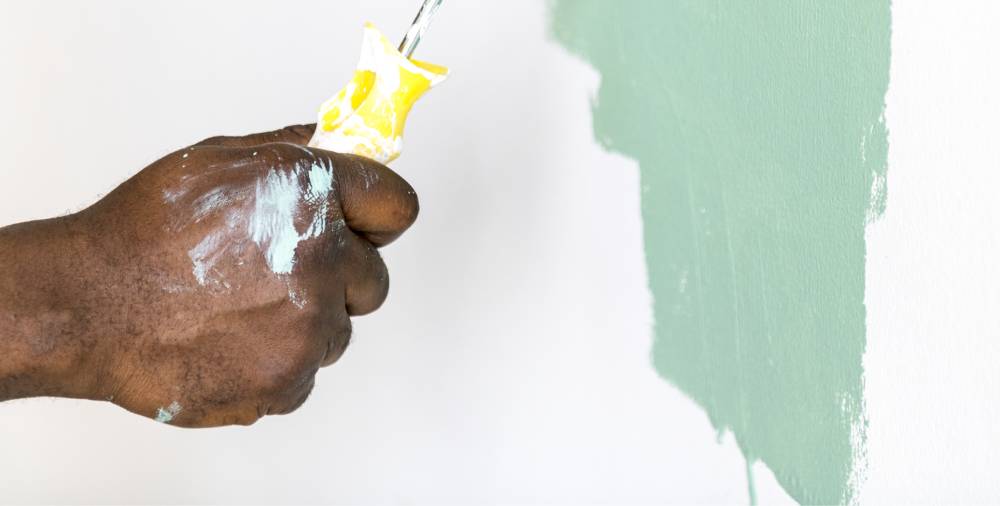Among the two basic types of paints (oil-based and water-based), water-based paint happens to be the most popular, and you can be sure to find it in every exterior and interior project at home and in offices. Its popularity can be attributed to its eco-friendly components, ease of cleaning, ability to dry quickly, and bearable odor.
Water-based paints are not new; in fact, they have been around since the 1800s when D.P Flinn received the first patent to commercially produce this type of paint. Over the years, the painting industry has improved the original formula to come up with more efficient, durable, and easily usable paint. Much of the developments have happened after 1940 after the introduction of latex, which made it possible to produce high-quality paint with enhanced applicability.
What Are Water-Based Paints?
Water-based paints are named so because they use water (instead of oil) to carry the paint binders. One distinct quality of water-based paint is that it does not emit fumes commonly associated with paints. Moreover, it does not require mineral spirits or turpentine to clean as it easily washes with soap and water.
Water-based paints exist in two types; acrylic paint and latex paint, each with distinctive qualities and purposes. Comparing the two can be confusing, especially because they have almost similar characteristics. See below to learn how you can choose between the two;
Acrylic paint – This type of paint has more acrylic polymers, therefore, it offers better adhesion, durability, and resiliency. It is particularly good for outdoor furniture and kitchen cabinets. Manufacturers may use the word ‘enamel’ to describe acrylic paint that is more durable.
Latex paint – Compared to acrylic paint, latex paint contains fewer acrylic polymers. It is especially good for vertical walls but not quite ideal for outdoor furniture. It is often a preferred choice for many individuals because it is less expensive, provides greater coverage, and is eco-friendly.
Benefits of water-based Paints
Water-based paints offer various benefits for your home as well as the environment. Here are some of its advantages:
Easy to apply
The applicability of water-based paints is relatively easy and quicker compared to other types of paints. For desirable results, use a synthetic brush on a clean surface as it ensures the moisture in the paint is absorbed well. Remember to dampen the brush as it helps the paint to flow smoothly. The fact that you don’t need to add spirit to thin the paint makes water-based paint a preferred option.
Odor-free
Unlike most paints, water-based paints have less odor when applied on surfaces. This makes them ideal for homes and offices as they protect you from irritating smells that many paints tend to have. Moreover, they don’t react with pollutants in the atmosphere, which makes them environment-friendly.
Easy to clean
With water-based paints, you do not have to put a lot of efforts (such as using white spirit) to clean your brush and hands after work. With only a little help from a hand wash, you can get the paint off in seconds. Since they do not have a strong odor, cleaning after the decoration is complete is less stressful.
Enduring elegance
Nobody wants to paint their walls every now then, so it is important to go for durable and enduring paint. Water-based paint is resistant to peeling that often results from prolonged exposure to different environmental conditions. There is also no yellowing of whites, meaning walls will keep their beauty and elegance for quite some time.
Multiple finishes
The multiple options that water-based paints offer (e.g., satinwood and gloss) ensure that you have broad choice when choosing your favorite finish. Moreover, you have the assurance that the coatings will be tough and durable. This offers protection for the long term, saving you from having to do retouches with the change of the seasons.
Quicker to dry
Compared to solvent-based paints, water-based paints tend to dry faster. Basically, they take between four and six hours to dry. This makes your job easier and saves you time as you can manage same-day recoating to get the job done.
Water-based Paints Disadvantages
Despite their many advantages, water-based paints have their negative qualities. They include:
• They tend to have low adhesion on raw metal and shiny surfaces
• They are difficult to use in temperatures below 50 degrees Fahrenheit
• They can raise the grain on unprimed wood
• They can show brush strokes if the proper technique of application is not applied
Choosing a Water-Based Paint
It is easy to get confused when choosing the right water-based paint for a particular project. This is more so because there are various varieties, with each variety having its special use and qualities. You sure want your exterior paint to last longer to save on expenses and ensure it can withstand different weather elements. Therefore, you need to have a deeper understanding of water-based paint to avoid disappointments.
One key component you ought to consider when choosing water-based paint is the acrylic resin content. Ideally, anything less than 100 percent acrylic for exteriors will not serve your needs optimally. However, even in paints with 100 percent acrylic content, the quality and durability may vary in different paints. It all depends on the technology used to manufacture the paint.
While here, it is worth noting that the higher the quality, the more durable and expensive the paint is. But it is always advisable to spend a few more dollars now to guarantee longevity rather than spend more on repainting every three years, which will obviously cost you more in the long run.
Test for Water-Based Paint
Do you know whether the paint on your wall is water or oil-based? If not, there is a simple test to confirm this: if you dig your thumb in the wall and it makes a dent, then you are looking at water-based paint, but if the finger doesn’t go in, the paint is oil-based.
You can also try removing the paint with a rag dipped in alcohol, and if it comes out, the paint is water-based. This information is essential when it comes to repainting your walls, as not all water-based paints can be applied on top of oil-based paints.
Call The Professionals
Having the knowledge about water-based paints in regard to the various types and their unique qualities can help you to make more informed choices when repainting your home. With this guide, you are sure to pick the right water-based paint according to your desires.
At Wet Paint, we only use quality water-based paints to give you the results you expect. With us, you can be confident that we will transform your home to suit your preferences. Contact us to choose from our wide variety of paints. You can request a quote by clicking here.

